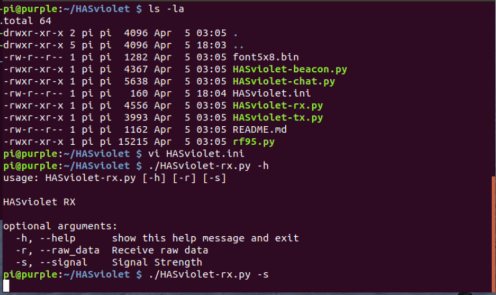 |
There are four demonstration applications that are built in to HASviolet. This article will discuss our receive (HASviolet-rx.py), transmit (HASviolet-tx.py) and chat (HASviolet-chat.py) applications plus some helpful tips and tricks to using them.
HASviolet RX & TX Applications
The HASviolet project is focused on providing a basic environment for learning. We are not promoting this as a fully developed application. The reason is so that many use cases can be enabled through HASviolet and its basic demonstration applications.
Our HASviolet-rx.py and HASviolet-tx.py applications are designed for others to integrate with other tools which can be used for specific applications.
An example in using the HASviolet-tx.py application could be as a mechanism to transport some sort of sensor data or status report.
The same would go with the HASviolet-rx.py application, but as a receiver of whatever information is sent to it and then further filtered, actioned or forwarded through add on software that will easily run on the Raspberry Pi Zero.
When using the HASviolet-rx.py application, you simply run it while in the HASviolet directory by typing:
./HASviolet-rx.py
You can add -s or -r to show either signal strength (RSSI, in dbm), raw data or both.
The only parameter in the HASviolet.ini file you should be aware of is the frequency. Our default to promote experimentation is on 911.250 MHz.
There are a number of modem parameters we have already configured that combine spread, bandwidth and speed.
Our next release of HASviolet will include a fancier interface, that will resemble the one used in raspi-config or what that the unrelated, but nice rpitx project has migrated to.
This new interface will provide easier to understand options to select optimum combinations for receiving and transmitting data to support different use cases.
Our transmit application offers the ability for you to specify where you want to send the message by using the "-d" function. Then, you can use the "-m" function followed by quotes to type what you wish to send.
HASviolet Chat Application
The HASviolet-chat.py application as shown in Joe's video will also be able to monitor any transmissions sent from a HASviolet-tx.py user as well as the HASviolet-beacon.py application, but its not the intended purpose.
The "chat" demonstration application does a few things that no other project based around the RFM95/96/97/98 LoRa capable modules when combined with a Raspberry Pi.
There are many LoRa projects that use the ESP32, ESP8266 and Arduino computers since they more easily handle handshakes via the GPIO.
While there is a benefit in using these lower CPU options such as lower power consumption, our goal in creating a project using the Raspberry Pi Zero is to eventually make use of its faster processor and flexibility in memory storage or configuration.
The HASviolet-chat.py application uses a special interrupt function which is initiated by the "Control Z" key sequence to break the receive or transmit loop which prevents these sort of "chat" based applications from being possible.
Joe NE2Z came up with this idea after gaining some insight from a few people that revolve around our local maker space called "Squidwrench".
He also got some helpful insight from Casey KC7IBT whom HVDN's founder, Steve K2GOG met during one of the Hackaday.io "hack chat" meetings this past December and introduced Casey into HVDN and Squidwrench.
The journey in creating the HASviolet-chat.py application has fulfilled some of the hopes and dreams for the project goals.
We not only met some people along the way, but were able to put that applied learning to good use where others may build upon our work. This journey also exposed the ability or inability for project team members to either learn new things or to admit the lack of knowledge in certain areas that needed improvement.
HASviolet: What is chat good for?
Having a basic chat application is not exactly the most exciting thing to have, but was a necessary evolution step for our more advanced applications already in development, such as our quasi secretive "duck-hunt" and "vasili" applications.
Perhaps, as an example use case for both our chat and further described beacon application can be to enable "troposcatter"or other long range communication methods using 911.250 MHz in the United States, or other frequencies in the 868 or 433 MHz spectrum bands.
Watch "HASviolet: Talking about RX and TX and Chat"





No comments:
Post a Comment
We really do not want to moderate comments, so lets keep it easy to use until it becomes an issue.